Last week, Judge Naomi Buchwald ruled against a series of class action suits that had been brought against banks, alleging that the banks were guilty of market collusion. The antitrust cases were predicated on the idea that banks got together to artificially lower rates, which in turn hurt investors. Judge Buchwald responded with a lengthy decision that said even if the banks colluded, the plaintiffs didn’t suffer because of that collusion. While it seems the result will be the end of the line for some cases, it’s not over for the banks.
LIBOR rigging
The two biggest players in the LIBOR scandal, so far, are Barclays PLC (ADR) (NYSE:BCS) and UBS AG (USA) (NYSE:UBS). Both companies have admitted that they made false reports to the British Bankers Association, which is responsible for setting the LIBOR. The reasons for the false submissions varied but were largely in one of two camps. Either traders at the bank wanted to make more money with a rate change, or the banks wanted to appear stronger than they were by submitting a lower rate.

Historically, the LIBOR was set by large institutions submitting the rate at which they believed they would be able to borrow money. By submitting a lower rate, banks gave the impression that they were in better financial standing than they really were — like a bankrupt friend telling you that he can get a 15-year mortgage at 2%.
Between Barclays PLC (ADR) (NYSE:BCS), UBS AG (USA) (NYSE:UBS), and the Royal Bank of Scotland Group plc (ADR) (NYSE:RBS), banks have been fined a total of over $2.5 billion by regulators. So far, those banks have avoided having to pay out to individual investors, and the recent result should keep those losses pushed off for a while — if they ever come.
Other avenues to pursue
While it was the end of the line for some of the plaintiffs, the judge did allow other cases to proceed. Specifically, cases that allege fraud seem to be in better standing, as the banks clearly lied. The difficulty for investors will be in proving that those lies caused them financial damage. That’s going to be very tricky, as the LIBOR was set in a way that took some submissions out every day.
In order to hold a bank culpable, a judge would have to agree that the plaintiff suffered because of a specific bank’s submission. But that submission probably didn’t make it in every day, and even if it did, it may not have had a noticeable impact on the LIBOR for the day.
Fraud is a little easier to prove. The banks lied and misrepresented themselves as submitters of true and honest data. To prove fraud also doesn’t require proving that the banks colluded, and it may have a longer statute of limitations.


